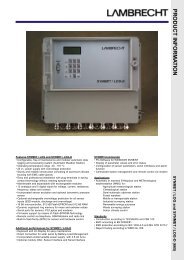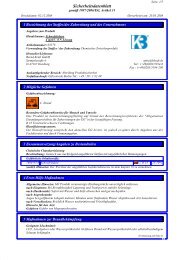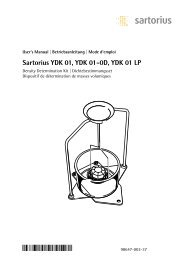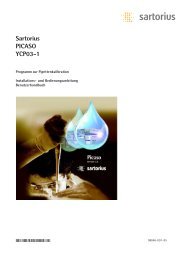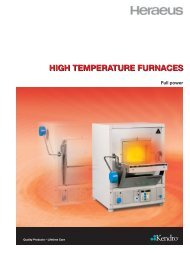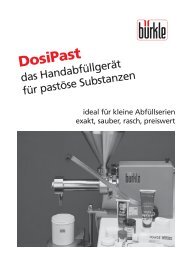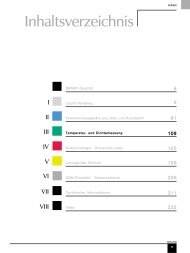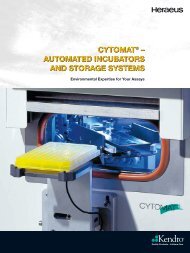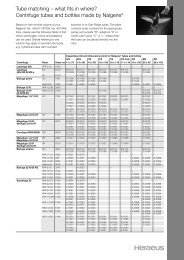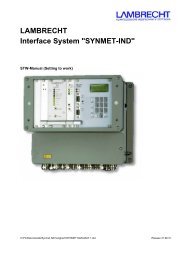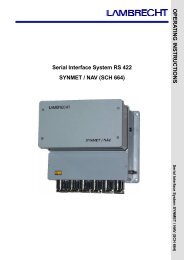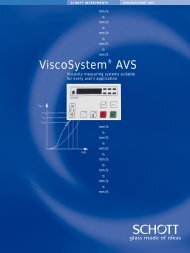ViscoSystemâ AVS 370 - Windaus
ViscoSystemâ AVS 370 - Windaus
ViscoSystemâ AVS 370 - Windaus
Create successful ePaper yourself
Turn your PDF publications into a flip-book with our unique Google optimized e-Paper software.
ViscoSystem ® <strong>AVS</strong> <strong>370</strong> – the right solution for all situations<br />
<strong>AVS</strong> <strong>370</strong><br />
Anyone working with the ViscoSystem ®<br />
<strong>AVS</strong> <strong>370</strong> is perfectly equipped for all tasks<br />
involved in determining viscosity using<br />
capillary viscometers.<br />
How to automatically achieve the<br />
right results<br />
PC-controlled, the ViscoSystem ® <strong>AVS</strong> <strong>370</strong><br />
determines the time which the liquid to be<br />
examined requires to flow through the<br />
measuring distance in the capillary viscometer<br />
with quartz precision. The time<br />
is displayed with a resolution of 0.01 s<br />
(1 digit).<br />
Measure the flow time the liquid’s meniscus<br />
can be scanned optoelectronically or<br />
with TC sensors. (During optoelectronic<br />
scanning the meniscus is detected by glass<br />
light fibres, with TC sensors the sensor<br />
detects the different thermal conductivity<br />
of the sample and air.) Therefore the<br />
ViscoSystem ® <strong>AVS</strong> <strong>370</strong> offers an extraordinary<br />
broad field of uses, which range from<br />
viscosity measurement of clear fluids<br />
through to black or fully opaque liquids.<br />
4<br />
New: Two working principles<br />
with the same device.<br />
For the first time ever, with the<br />
ViscoSystem ® <strong>AVS</strong> <strong>370</strong> you can<br />
use the same device to work with<br />
“pressure“ or “suction“. This<br />
gives you more flexibility and<br />
better adjustment to the liquids<br />
to be examined.<br />
In the “pressure“ method of<br />
working an overpressure of up to<br />
0.1 bar is applied to the liquid in<br />
the capillary, this is particularly<br />
advantageous for fluids with a<br />
low boiling point. In the “suction“<br />
principle the sample is<br />
sucked up into the capillary by a<br />
vacuum. A greater reproducibility<br />
of results is achieved using the<br />
“suction“ method for higher viscosity<br />
samples. A further advantage<br />
of the “suction“ principle is<br />
that it guarantees formation of the<br />
“hanging ball level” in Ubbelohde<br />
viscometers, even for the minimum<br />
required sample quantities.<br />
“Suction“ or “pressure“? A comparison of preferred applications<br />
“pressure“ “suction“<br />
Highly viscous samples e.g. oils, polymers yes yes<br />
Solvent (examples): highly volatile yes no<br />
Dichloromethane yes no<br />
Chloroform yes no<br />
Sulfuric acid no yes<br />
Dichloroethanoic acid no yes<br />
Toluene yes yes<br />
Hexafluoroisopropanol no yes<br />
m-cresol no yes<br />
Formic acid no yes<br />
Phenol-dichlorobenzene no yes<br />
Phenol-tetrachloroethane no yes<br />
Working with the ViscoSystem ® <strong>AVS</strong> <strong>370</strong><br />
is easy<br />
The ViscoSystem ® <strong>AVS</strong> <strong>370</strong> is very easy to<br />
use. The whole measuring procedure<br />
takes place automatically, subjective measuring<br />
errors are reliably precluded. The<br />
PC starts the measurement. After the set<br />
pretempering period has expired the entered<br />
number of measurements are carried<br />
out and the measured values saved.<br />
The system can be protected against accidental<br />
overpumping or oversuction by<br />
means of a capacitive sensor. This prevents<br />
the sample to be measured from getting<br />
into the vessel containing the tempering<br />
liquid or inside the device.



